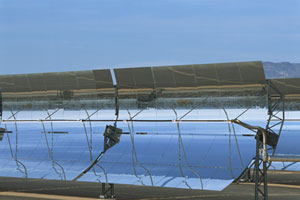|
ILLUMINATING THE NIGHT WITH THE POWER OF SUNSHINE
by Mark Greenawalt,©2009
Originally published on azbigmedia.com

The old parlor trick of a light bulb burning when it
is clearly not “plugged in” was the precursor to
modern street and area lights that are not
connected to the electrical system. This is no
cheap trick though; it is the evolution of LED
lighting and solar power.
Companies such as Solar Outdoor Lighting,
SolarPath Sun Solutions and Se?lux are producing
poles outfitted with photovoltaic panels, storage
batteries and dark-sky compliant LED light
fixtures. Since the power is derived from the sun, proximity to electrical power is not required,
and consequently, there are no associated costs for trenching, wiring and conduit. At
approximately $21 per linear foot of trench, backfill and circuiting, the first cost savings in some
cases gives immediate payback for any additional costs of solar-powered lighting.
The technology isn?t necessarily new, but as LED lamps continue to produce more light while
using less power and photovoltaic panels collect more power per square inch of surface area,
the concept has become more viable. Many of the same design principles for grid-tied solar
panels still apply: aim panels toward the sun?s location at noon on the equinox; locate panels
where they aren?t shaded by trees or buildings; keep the panels clean; and choose panels of
adequate size and efficiency to collect sufficient power for the application.
There are also design parameters for the batteries. Here in Arizona we have over 300 days of
sunshine each year, but that leaves just a few overcast days that would limit the intake of solar
power. The batteries need to be sized to store enough power for multiple nights. Although the
sunny days are typically a plus for Arizona, the ambient temperatures tend to significantly
shorten the life of batteries. The shade of the solar panel helps, of course. Project location can
also be critical in regards to the short winter days having limited hours of solar radiation
collection for recharging the batteries. From an engineering standpoint, the length of time that
the lights need to operate must be taken into consideration when sizing the system. Motion
sensor controls may be beneficial to reduce light levels when the area is unoccupied, and
subsequently, reduce energy usage.
LED area lights are beginning to match the light output of their
metal halide and high-pressure sodium predecessors while
reducing the power consumption, lengthening the life of the lamp
and improving the quality of light. Not all of these are intended to
be powered from a solar system, but all have the ability. Beta
Lighting is at the forefront of the industry with a series of sleek
designed LED lighting fixtures for pole- and wall-mounted
applications. Kim Lighting has just introduced their latest version of
the Warp-9 fixture with LED lamping. I can only wonder if it was a
coincidence that it was released concurrently with the Star Trek
motion picture!
Solar lights were initially relegated to remote locations such as
parks, marinas and observation stations, so they historically haven?t
been aesthetically pleasing to most designers. The conglomeration
of the panel, battery housing and light fixture looks like a lot of hardware on top of a pole. The
lure of renewable energy, however, is making solar lighting a green initiative worth considering — and these fixtures are now finding their way into corporate parking lots and pedestrian
walkways where electrical power would have been easily attainable. As the technology
improves, the photovoltaic panels and battery housings may become smaller and allow the
aesthetics of the fixtures to become more palatable, and eventually, solar lightingsolutions may
become the standard in outdoor lighting applications — unlike the antiquated light bulb trick.

Mark Greenawalt, PE, LC, LEED AP, is a chief electrical engineer at SmithGroup?s Phoenix
office. Specializing in lighting design, he is Lighting Certified by the National Council on
Qualifications for the Lighting Professions.
Mark Greenawalt
http://www.futureclassx.com

|


